10 Vines with Small Purple Flowers
You want to plant some vines in your yard, but you want to make sure they have small purple flowers first. The good thing is that you have a wide variety of plants to pick from. The majority of these small purple-flowered vines grow swiftly, so you can expect to see them cover a large area in only one season. These plants are ideal for creating a greener space in your garden if you desire an arbor or trellis. You may train them to walk on various surfaces for decorating, and you can even teach them to climb up walls if you provide them with adequate support.
Please remember that a few of the small flowering vines we’ve spoken about can be a little too invasive for your gardening needs. They may, however, be used as an attractive plant with some regular trimming. Let’s get right in and have a look at some of our favorite small purple flowering vines for your home garden!
1. Bougainvillea

Plant Type: Perennial, Annual
Origin: Brazil
Plant Height: 15 to 40 feet
Sun Need: Full sun
These thorny small flowering vines can grow to a height and spread of 15-40 feet. Technically, the flower is considerably smaller and not nearly as attractive. Orange, scarlet, and, of course, purple are among the bright colors produced by the Bougainvillea vine. The Bougainvillea’s real flowers are small and white, but the bracts (big modified leaves) that surround them produce vibrant color.
Bougainvillea is a tall, woody vine with small flowers that bloom in the spring and continue into the fall. Bougainvillea is a good purchase for any purple-loving gardener since it produces one of the most beautiful purple vines. Keep in mind that this plant is classified as invasive in some parts of the country.
Whether you living in a cold climate, these little blooming vines can be kept as ornamentals or brought within during the wintertime and treated as houseplants until the summer. If you’re growing them indoors for the winter, be sure you don’t overwater them. Fertilizing every other week is the standard guideline (during the summer).
2. Clematis Vine
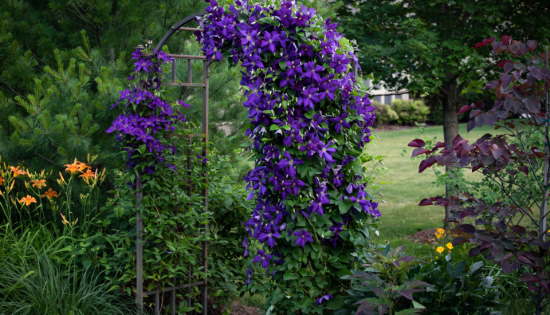
Plant Type: Perennial
Origin: China, Japan, Europe
Plant Height: 10 to 15 feet
Sun Need: Full sun or partial shade
Clematis is a vine that has a small purple flowering vine that blooms in the summer with small purple star-shaped flowers. The Clematis spreads tendrils to climb metal fences, trellises, walls, and even poles. Clematis is one of the hardiest climbing small flowering vines, growing swiftly and thriving even in colder climates. Clematis comes in over 300 distinct varieties, making it an extremely adaptable purple small flowering vine.
Clematis hybrids are popular among gardeners because they produce magnificent flowering floral small flowering vines that may give a backyard arbor a mysterious feel.
In the spring and summer, non-organic growers supplement compost with treatments of a manufactured balanced fertilizer such as 10-10-10. Mulch the plant’s base to keep the roots cold, even in the North.
When the soil is dry, water it, but do not go extreme. Clematis thrives in soil that is kept equally wet around its roots.
Clematis may be grown in pots, but they will demand more care than their wild relatives in your yard. Plant in a big pot since the extra dirt will protect the roots. Use a light potting mix and a trellis from the start. Water on a regular basis and fertilize once or twice during the flowering time.
3. Hyacinth Bean Vine
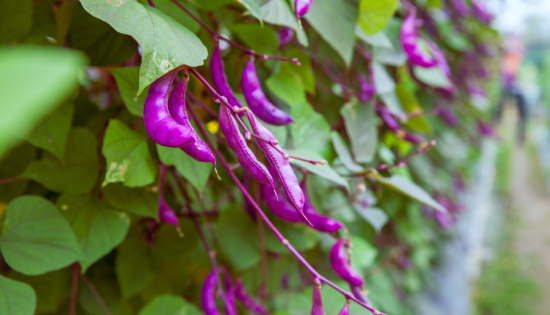
Plant Type: Annual
Origin: Africa, Asia
Plant Height: 10 to 15 feet
Sun Need: Full sun
The Hyacinth Bean Vine is a dense and robust small flowering vine with burgundy stems and pastel purple bracts. The bean pod has a purple color, and the leaves are big and shaded.
Planting these small flowering vine near a trellis, for example, will encourage it to swiftly drape over the top and the sides, but it does not spread to other parts of your yard.
While purple hyacinth beans are cultivated as a field crop in various parts of the world, they are unfit for human food since they require special preparation. Instead, they’re best appreciated as landscape ornamentals. The seed pods can be gathered by individuals who desire to cultivate more plants.
Knowing when to pluck purple hyacinth bean seed pods is therefore beneficial. The pods begin to grow in size once the small flowers have died away. Harvesting the bean seed is best done shortly before the first frost. Seeds are easy to store and can be used in the garden the following year. Seeds from dried seedpods may be readily extracted and stored.
4. Lavender Trumpet
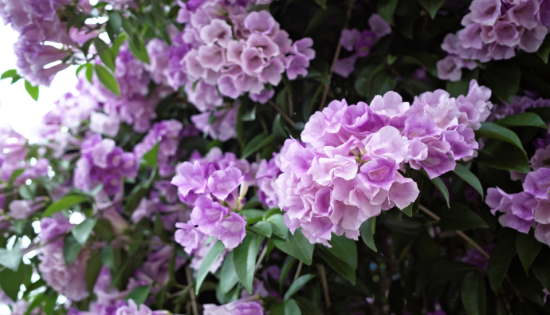
Plant Type: Perennial
Origin: Brazil
Plant Height: 15 to 20 feet
Sun Need: Full sun, partial shade
The Lavender Trumpet Vine is a little small flowering woody purple vine with dense leaves that blooms small flowers that look just like the name suggests. The small light purple coloring wonderfully blends a pastel tone into your landscape, and the three-inch-wide small flowers resemble the bell of a trumpet.
Because of its thick branches, the Lavender Trumpet Vine might quickly climb any available wall or surface. If the vine is not maintained in check, it can do significant harm to its support.
When digging holes for new small purple vine plants, apply fertilizer into the soil. Early in the spring and again midway through the growing season, mature plants should be fed. Late in the growing season, avoid fertilizing. This encourages new growth, which is vulnerable to early frost damage.
Fertilizers can be found in a variety of forms, including granulated, slow-release, liquid feeds, organic, and synthetic. Find a product with a nutrient content designed to enhance flowering and determine which application technique is appropriate for the condition (such as 5-10-5).
5. Morning Glory
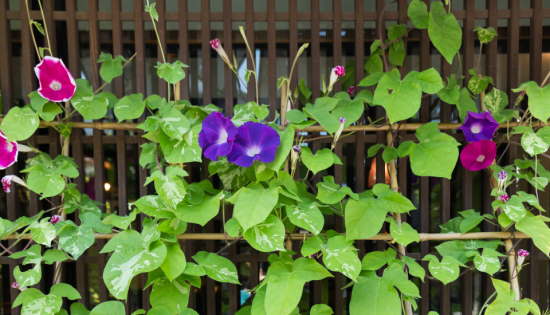
Plant Type: Perennial, Annual
Origin: Mexico, Central America
Plant Height: 6 to 10 feet
Sun Need: Full sun
The Morning Glory vine, named for its habit of flowering every morning, will unfold its blooms early in the day and seal them at night. Morning glory is a multipurpose plant with thousands of distinct types to select from.
The trumpet-shaped blooms are one to two inches in diameter and have a broad trumpet shape. Shades of indigo or deep purple are created when the purple color is tinted with blue. Each bloom features a star-shaped design when seen from the front.
Morning Glories are drought-resistant and frequently self-seed, making them potentially invasive. Because the seeds are dangerous, keep them out of reach of pets and children.
Regularly water your morning glories, about one inch each week, and mulch around the roots to keep moisture in. During the growth stage of the plant, the most moisture is required. Once the plant has been established, you may reduce the frequency of watering.
6. Snapdragon Vine
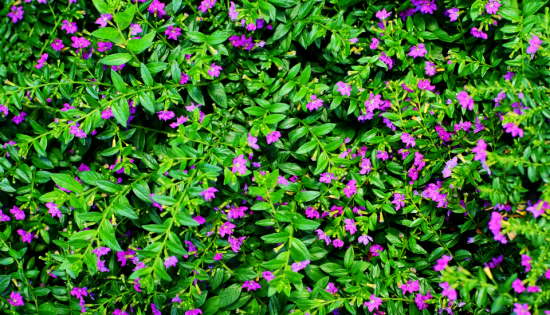
Plant Type: Annual
Origin: North America
Plant Size: 1 to 3 feet
Sun Need: Full sun, partial shade
The Twining Snapdragon scales nearby plants and structures in a vine-like manner, although not being a genuine purple small blossoming vine. With characteristic cape and mouth-like structures, the small flowers preserve the peculiar morphology of the regular Snapdragon.
The small flowers of the Twining Snapdragon are deep purple, with bluish or white highlights. The thin and clinging stems contribute to the plant’s diminutive size. The Twining Snapdragon is a wonderful option for thicker or woodier plants if you don’t have a trellis or equivalent framework for a climbing small flowering vine.
Mid-season fertilization with a full fertilizer will give the snapdragon vine the fuel it needs to remain flowering until early October. Alternatively, add a coating of compost to the plant’s base to give it a nutritional boost.
7. Wisteria

Plant Type: Perennial
Origin: Asia, North America, Iran
Plant Height: 30 to 60 feet
Sun Need: Full sun, partial shade
Wisteria is a woody twining small flowering vine having purple flowers that dangle from the branches. Wisteria requires hard support to grow because of its twining vine.
Wisteria flowers make a conical brush with several little flowers crowded together over the vine when in bloom. The hanging small purple flowers might be blue or pink, but their primary color is purple. Wisteria is well-known for its ability to thrive in the sun, but based on your hardiness zone, it may also thrive as a vine in the shade.
Use phosphorus-rich fertilizer (the P in the NPK). Don’t fertilize wisterias with nitrogen because they belong to a botanical family that can fix nitrogen. They’ve already had enough. The optimal time to fertilize is in the early spring.
When you see dead, damaged, or diseased growth, trim it off like you would any other plant. Because they’re so strong and spread by runners, you’ll need to trim them every year to keep them in check.
8. Passion Vine

Plant Type: Perennial
Origin: Central, North, and South America
Plant Height: 6 to 30 feet
Sun Need: Full sun, partial shade
The passionflower, a fabulously distinctive small purple flower named after Christ’s passion, grows on the Passion Vine. Most species yield passionfruit in addition to being decorative.
The radial filaments, 10 petals, and triple stigma distinguish Passion Vine flowers. The radial threads, in particular, are generally pale purple or blue in hue, though they can be any color.
Passion Vines are commonly trained over trellises by gardeners to better exhibit their tropical-looking small purple flowers. Passionflowers should be watered right after planting. Aside from that, they usually only need either one or two waterings every week during the growing season. If there isn’t any rain, be sure to give them around 1 to 1.5 inches of water per week because they don’t take drought well.
9. Purple Sky Vine
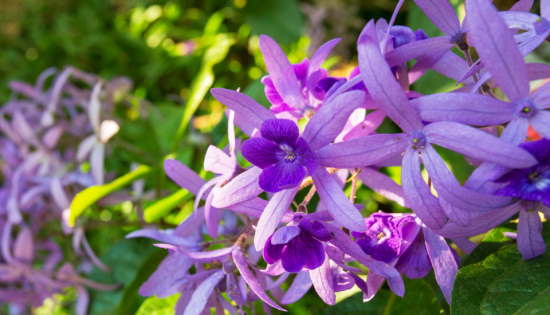
Plant Type: Perennial, Annual
Origin: India and South Asia
Plant Height: 15 to 30 feet
Sun Need: Full sun, mostly sun, or partial shade
The huge, trumpet-shaped small purple flowers of the Purple Sky Vine are usually three inches wide. This tropical vine’s purple-throated little purple blossoms will attract butterflies, honeybees, and songbirds to your backyard. When compared to other vines, this perennial blooming vine is genuinely one of the less commonly planted.
Despite its name, Purple Sky produces delicate bluey-purple blooms that are similar to lilacs. Purple Glory Vine, a close sibling of Purple Sky, provides a considerably brighter blue that steers clear of the purple undertones.
The Purple Sky Vine, despite its tropical roots, is a robust plant that can survive winters. It climbs trellises, arbors, and even metal fences in medium to big sizes. It may also be grown as ornamental plants in a container.
10. Dutchman’s Pipe
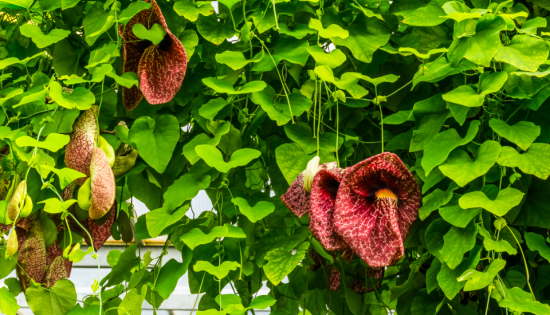
Plant Type: Perennial
Origin: North America
Plant Height: 15 to 30 feet
Sun Need: Full sun, partial shade
Dutchman’s Pipe is a distinctive alternative that may make your garden stand out, even though it isn’t the first pick for many gardeners seeking climber vines with purple blooms. The name “Dutchman’s Pipe” comes from the flower’s form and lobes, which are shaped like a Dutch smoking pipe.
The bloom features a greenish-yellow flower with two to three dark maroon-purple lobes encircling it. The Dutchman’s Pipe requires wet soil and will struggle in drier conditions.
Keep the soil uniformly moistened during the plant’s growth period for the best results. When watering, aim the hose towards the plant’s base; wetting the thick leaves too directly can cause fungal problems. Pipe vines require ground that drains well above all else; however, they will thrive in soil that is equally rich and damp. Pipe vines don’t care about the pH of the soil, and they can survive in both normal and acidic conditions.
If ingested, this vine can cause major health problems. The Dutchman’s Pipe is a plant you don’t want to eat, even if it looks great snaking over your fences, walls, or trellises.
Conclusion
Purple flowering climbing vines are a lovely addition to walls, trellises, and trees. They may go with almost any color scheme in your landscape. They may also help you fill in any gaps in your progress. Take a risk on one of these purple blooming vines this season if you want to give your landscape a charming appearance.
You may also be interested in:
Walking Iris Plants : How to Grow & Care
Sea Thrift (Armeria Maritima) : How to Grow & Care
Shrimp Plant: How to Grow and Care
Japanese Anemone (Anemone Hybrida): How to Grow & Care
Heartleaf Bergenia (Bergenia Cordifolia): How to Grow and Care
